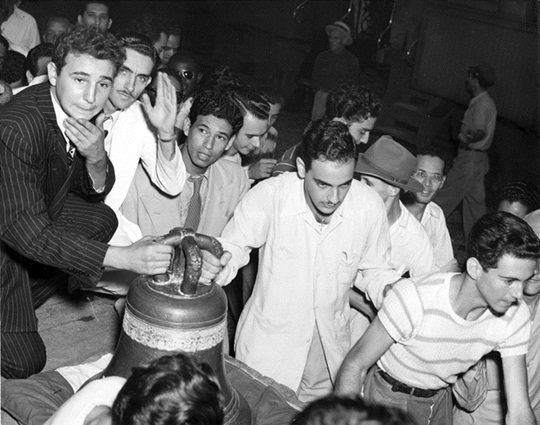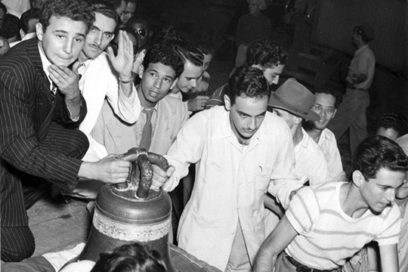 When Fidel Alejandro Castro Ruz arrived at the Law School at the University of Havana on September 4, 1945 there was a struggle between two forces in contradictions: one belonged to the students, a glorious legacy from Julio Antonio Mella, Ruben Martinez Villena and other outstanding figures of the students’ movement, and the other made of gangsters and reactionary people who, taking advantages of the Federation of University Students (FEU) made their greatest efforts to be promoted to any post in political, economic, social and even military institutions.
When Fidel Alejandro Castro Ruz arrived at the Law School at the University of Havana on September 4, 1945 there was a struggle between two forces in contradictions: one belonged to the students, a glorious legacy from Julio Antonio Mella, Ruben Martinez Villena and other outstanding figures of the students’ movement, and the other made of gangsters and reactionary people who, taking advantages of the Federation of University Students (FEU) made their greatest efforts to be promoted to any post in political, economic, social and even military institutions.
The Jesuit fathers from Belen college, during his graduation as bachelor in 1945 wrote in the yearbook: “Fidel Castro (1942-1945). He highlighted in all the subjects related to letters. Excellency and congregation, he was a real athlete… He has won the admiration and love of all. He will study Law and we do not question at all, he will fill with brilliant pages the book of his life. He has got the wood and there will be the artist.”
He was officially registered nevertheless he was just 19.
Fidel could immediately notice what was going on. He expressed his opinions and the need to change that situation. He told that to journalist and writer Ignacio Ramonet, who wrote so in his book 100 hours with Fidel: “Since the first day I arrived to the university, I saw an atmosphere of force, fear and weapons. There was a university policy completely controlled by allied groups of power. It was a bastion in the hands of a corrupted government.”
Let’s Fight!
He quickly started as leader of the FEU, because his new partners elected him as delegate in the first year, and in the next course he was elected president of the school. By then, he hardly opposed to the favorites to Ramón Grau San Martín’s government to lead the students’ federation, and the gangsters, to avoid him enter the university but they could not manage do so, because Fidel had the support and protection of his comrades.
In his studies at the university, he got the experiences that helped him have a better comprehension of the national policy, and he was ideologically trained with the reading of the works of the classics of Marxism. He also closed relations with Juventud Socialista movement, an organization of the Popular Socialist Party, although he was never a member of it.
It was the beginning of his political career that led him become an indisputable leader of the Cuban revolutionary process that changed the destiny of the nation.
His political activities put in danger his life. He founded the committees 27 de Noviembre and 30 de Septiembre to honor the eight medicine students executed in 1871 by the Spanish colony and the murder of Rafael Trejo who was deadly wounded in a students’ manifestation against Gerardo Machado’ tyranny in 1930. He was also responsible in moving the bell from Demajagua refinery -whose tolls made a call to the Cubans to the first war of independence- from Manzanillo to the University of Havana. All this, to prevent they use it as political purposes by Ramón Grau San Martín’s government. Fidel opposed to his reelection and said, “it is true that Machado and Batista killed many Cubans, but Grau had killed the faith of the entire people.”
He was one of the speakers who condemned, at the Presidential Palace, the murder of Carlos Martínez Junco after he arrived there in a manifestation, the departure place was the stairs of the university. He founded the Cuban-Ortodox People’s Party together with Eduardo Chibas who defended the cleaning up of the public life.
He also started to put into practice a solidarity feeling when participating in the expedition to Cofites Key, beyond the Cuban frontier- organized to fight Rafael Leónidas Trujillo’s tyranny in Santo Domingo in 1947, during a popular uprising that in Bogota drove to the murder of President Jorge Eliecer Gaitán, in 1948.
Fidel also supported the decolonization of Puerto Rico, the returning of the Falklands to Argentina, as well as the Panama Canal.
These were the goals of the agenda for a students’ congress aimed to found the Latin American Students Federation, which had the active participation of Fidel Castro representing the FEU.
After the triumph of the Revolution he leaded, the internationalist vocation will reach higher levels with the unselfish aid given by Cuba to other peoples in their struggles.
From 1948 on, he registered in the free modality so he could keep on working in policy. On October 13, 1950 he graduated as Doctor in Law, Diplomatic Law and Administrative Law and he stayed at the university until he managed to pass the subjects to also graduate as Doctor in Social Sciences.
He once said: “In that university, where I simply arrived with a rebel spirit and some elemental ideas of justice, I became a revolutionary, I became Marxist-Leninist and got the values I defend and had fought all my life.”
Acerca del autor
Graduada de Licenciatura en Periodismo, en 1972.
Trabajó en el Centro de Estudios de Historia Militar de las Fuerzas Armadas Revolucionarias (FAR), en el desaparecido periódico Bastión, y como editora en la Casa Editorial Verde Olivo, ambos también de las FAR. Actualmente se desempeña como reportera en el periódico Trabajadores.
Ha publicado varios libros en calidad de autora y otros como coautora.
Especializada en temas de la historia de Cuba y del movimiento sindical cubano.


